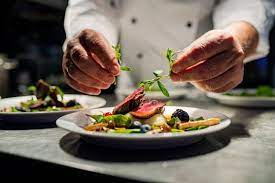by Dwight Furrow
 Is there such a thing as tasting expertise that, if mastered, would help us enjoy a dish or a meal? It isn’t obvious such expertise has been identified.
Is there such a thing as tasting expertise that, if mastered, would help us enjoy a dish or a meal? It isn’t obvious such expertise has been identified.
The most prominent model of tasting expertise is derived from the practice of wine tasting and has been extended to the assessment of cheese, coffee, chocolate, beer, spirits, and a variety of other products. These products are notably complex and exhibit flavors and aromas that are difficult to detect yet important to the quality of the product. The aim of expert tasters is to break the taste object into its component flavors, aromas, and textures so each element can be clearly identified and named with the help of flavor wheels that sort these flavors into categories. The expertise required for such analytic tasting is one of discernment—identifying hidden aromas or flavors that untrained tasters might miss. Analytic tasting is useful for assessing products, identifying the origin of a product, or training one’s ability to discern flavors. However, analytic tasting pays only cursory attention to how flavors and textures are then knit together to form a coherent whole.
By contrast, typical diners when enjoying a dish or meal are less interested in identifying hidden aromas or flavors and more interested in whether the elements fit together coherently. The enjoyment of complex dishes, as well as several dishes served as part of a meal, involves tasting relations between multiple taste objects rather than discrete, individual taste objects. But what kind of relations are we tasting? Part/whole relations would be the obvious type. For a dish or meal to be aesthetically successful, ingredients and flavors must be perceived as being fully integrated parts of a coherent whole.
In aesthetics, this relationship between whole and parts has traditionally been understood in terms of organic unity. Read more »

 In
In  It might strike you as odd, if not thoroughly antiquarian, to reach back to Aristotle to understand gastronomic pleasure. Haven’t we made progress on the nature of pleasure over the past 2500 years? Well, yes and no. The philosophical debate about the nature of pleasure, with its characteristic ambiguities and uncertainties, persists often along lines developed by the ancients. But we now have robust neurophysiological data about pleasure, which thus far has increased the number of hypotheses without settling the question of what exactly pleasure is.
It might strike you as odd, if not thoroughly antiquarian, to reach back to Aristotle to understand gastronomic pleasure. Haven’t we made progress on the nature of pleasure over the past 2500 years? Well, yes and no. The philosophical debate about the nature of pleasure, with its characteristic ambiguities and uncertainties, persists often along lines developed by the ancients. But we now have robust neurophysiological data about pleasure, which thus far has increased the number of hypotheses without settling the question of what exactly pleasure is.
 The term “gastronomy” has no agreed-upon, definitive meaning. Its common meaning, captured in dictionary definitions, is that gastronomy is the art and science of good eating. But the term is often expanded to include food history, nutrition, and the ecological, political, and social ramifications of food production and consumption. For my purposes, I want to focus on the conventional meaning of gastronomy for which that dictionary definition will suffice.
The term “gastronomy” has no agreed-upon, definitive meaning. Its common meaning, captured in dictionary definitions, is that gastronomy is the art and science of good eating. But the term is often expanded to include food history, nutrition, and the ecological, political, and social ramifications of food production and consumption. For my purposes, I want to focus on the conventional meaning of gastronomy for which that dictionary definition will suffice.